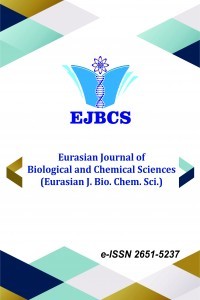The effect of neopterin alone or in combination with doxorubicin, cisplatin and vitamin C on the viability of different hepatocellular carcinoma cell lines
The effect of neopterin alone or in combination with doxorubicin, cisplatin and vitamin C on the viability of different hepatocellular carcinoma cell lines
HCC, neopterin, doxorubicin, cisplatin, vitamin C,
___
- Antoniello S, Auletta M, Magri P, and Russo N 1992. Serum Neopterin Levels in Patients with Hepatocellular Carcinoma. Biological chemistry Hoppe-Seyler 373(11): 1165–68. Capece D , Fischietti M, Verzella D , Gaggiano , Cicciarelli G, Tessitore A, Zazzeroni F, Alesse E 2013. The Inflammatory Microenvironment in Hepatocellular Carcinoma: A Pivotal Role for Tumor-Associated Macrophages. BioMed research international 2013: 187204.
- Daher S, Massarwa M, Benson AA, Khoury T 2018. Current and Future Treatment of Hepatocellular Carcinoma: An Updated Comprehensive Review. Journal of clinical and translational hepatology 6(1): 69–78.
- Godai K, Daito K, Yamada S, Uemasu J, Horie Y, Suou T, Kawasaki H 1994. Clinical Significance of Serum and Urinary Neopterins after Transcatheter Arterial Embolization for Hepatocellular Carcinoma Nihon Shokakibyo Gakkai zasshi The Japanese journal of gastro-enterology 91(6): 1097–1103.
- Hoffmann G, Kenn S, Wirleitner B, Deetjen C, Frede S, Smolny M, Rieder J, Fuchs D, Baier-Bitterlich G, Schobersberger W 1998. Neopterin Induces Nitric Oxide-Dependent Apoptosis in Rat Vascular Smooth Muscle Cells. Immunobiology 199(1): 63–73.
- Lv H, Wang C, Fang T, Li T, Lv G, Han Q, Yang W, Wang H 2018. Vitamin C Preferentially Kills Cancer Stem Cells in Hepatocellular Carcinoma via SVCT-2.npj Precision Oncology 2(1): 1.
- Hoffmann G, Wirleitner B, Fuchs D 2003. Potential Role of Immune System Activation-Associated Production of Neopterin Derivatives in Humans. Inflammation Research 52(8): 313–21.
- Huber C, Batchelor JR, Fuchs D, Hausen A, Lang A, Niederwieser D, Reibnegger G, Swetly P, Troppmair J, Wachter H 1984. Immune Response-Associated Production of Neopterin. Release from Macrophages Primarily under Control of Interferon-Gamma. Journal of Experimental Medicine 160(1): 310–16.
- Jindal A, Thadi A, Shailubhai K 2019. Hepatocellular Carcinoma: Etiology and Current and Future Drugs. Journal of Clinical and Experimental Hepatology 9(2): 221–32.
- Lewis M, Merched AJ 2014.Tumor-Associated Macrophages, Inflammation and Pathogenesis of Hepatocellular Carcinoma. Journal of Molecular and Genetic Medicine 08(03).
- Mazzanti R, Umberto A, and Renato T 2016. Hepatocellular Carcinoma: Where Are We? World journal of experimental medicine 6(1): 21–36.
- Yayın Aralığı: Yılda 2 Sayı
- Başlangıç: 2018
- Yayıncı: Muhammet DOĞAN
İmge KUNTER, Niloufar ZABİB, Marianna NAJJAR, Yelin SUBASI, Gonul SAHİN
LPS’nin böbrek DNA’sı üzerine akut toksik etkisi ve apilarnilin koruyucu rolü
Züleyha DOĞANYİĞİT, Sibel SİLİCİ, Emin KAYMAK, Aslı OKAN, Dilek PANDIR
The Effect of Repeated Doses of Ketamine on Hematological Parameters in Rats
